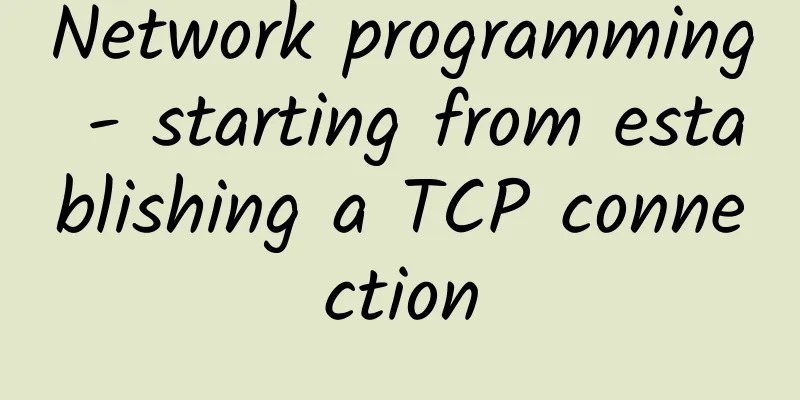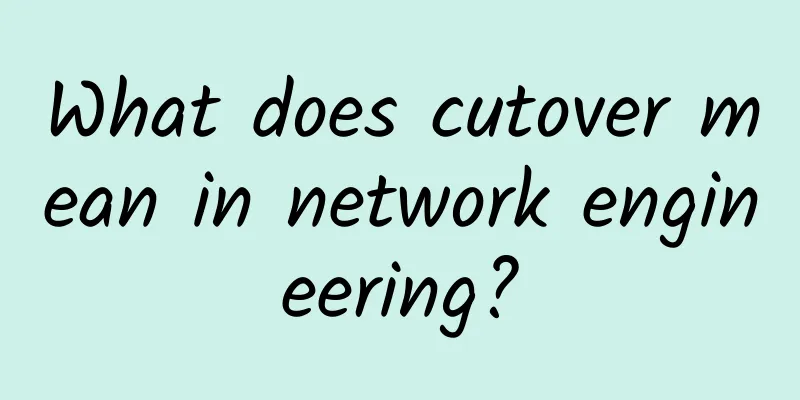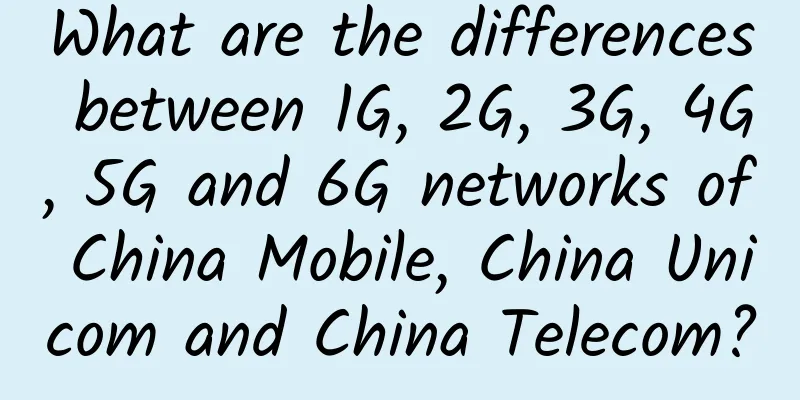Network programming - starting from establishing a TCP connection

|
PrefaceNetwork programming is something that almost every programming language involves. Although the calling methods of different languages may be different, the principles behind them are the same. Therefore, this article will start with the establishment of TCP connections. Before that, it is assumed that you have a basic understanding of computer networks. What does network programming do?There are countless network applications nowadays, such as WeChat, which allows you to communicate with friends in a foreign country through the Internet; online videos, which allow you to watch your favorite videos through the Internet, and all of these are supported by network programming technology. In layman's terms, network programming can be considered as data exchange or transmission between two or more hosts (applications). TCP: Transmission Control ProtocolData exchange needs to follow certain rules, and these rules are protocols. Only by following the agreed rules can the two parties exchange data correctly. TCP is one of these protocols, which provides a connection-oriented, reliable byte stream service.
Why understand TCPIn fact, you can still write code without understanding the basic principles behind TCP, but when you encounter some strange problems that cannot be solved by the API instructions, you will be glad that you spent some time to learn TCP. TCP connection establishmentYou may have heard of the establishment of a TCP connection and can recite the process by heart. But I think it is necessary to sort it out again. The establishment of a TCP connection, that is, the process of the three-way handshake is as follows: Let's try to describe the three-way handshake process:
So far, the three-way handshake is completed. It should be noted that this is a three-way handshake under the normal process. The above-mentioned states can be viewed through the netstat command or ss command. Of course, some states exist for a short time and may not be observed. Okay, so here comes the question:
If you can answer all the above questions easily, you can skip the rest of this article. Why three-way handshake?This is a question that is almost always asked in an interview. A TCP connection is full-duplex, meaning that data can be transmitted in both directions simultaneously. Therefore, the process of establishing a connection must ensure that both parties have normal sending and receiving capabilities. Is a four-way handshake possible? Absolutely! But it is not necessary! After the server receives SYN, it can reply ACK first and then send SYN, but these two messages can be sent together, so it is not necessary. Is a two-handshake possible? Imagine a situation where a client initiates a connection request that stays in the network for a long time, so that it reaches the server only after the connection is established and disconnected. If a two-handshake is used at this time, the server will think that this message is a new connection request, so it will establish a connection and wait for the client to send data. However, the client actually does not send a request to establish the connection and will not pay attention to the server, so the server waits in vain and wastes resources. Why does the server think that this late message is a new connection request? Because if a two-way handshake mechanism is used, the server cannot use SYN to determine whether this is a late or duplicate message or a normally arrived message. However, for a three-way handshake, even if this happens, a real connection will not be established on the server. A normal three-way handshakeWe use the tcpdump command and the nc command to observe a normal TCP connection establishment process. First, prepare to capture packets at terminal 1:
Start listening on port 1234 in terminal 2:
In terminal 3 connect:
The following output is obtained in Terminal 1:
From the packet capture above, we can see that there are three packets in total, namely the SYN sent by the client to the server, the SYN and ACK responded by the server to the client, and the ACK responded by the client to the server. Connecting to a non-existent portWhat will happen if the server port to be connected does not exist? We use the nc command to capture the packet and observe. In a terminal window, use administrator privileges to execute the following command to capture packets and print relevant information:
In another terminal, use the nc command to try to connect to the local port 1234
The TCP packet capture content is as follows:
From the captured packet content, we can see that the nc client first sends a SYN (Flags is S) with a seq of 1175796450. Then it receives a RST (Flags is R) with a seq of 1175796451. That is to say, if you connect to a non-existent port, the system where the server is located will respond with an RST (reset) and terminate the connection directly. The meaning of the Flags field is as follows:
Connecting to a non-existent server The same is done using the nc and tcpdump commands.
In another window, use the nc command to connect to a server address that does not exist or cannot be connected:
The tcpdump output is as follows:
Through actual operation, it can be found that when there is no response to the first SYN sent, the client will send it again; if there is still no response, it will continue to send SYN after a longer period of time, and finally the connection will time out. From the observation, it is observed that the default retransmission is 5 times, and the retry intervals are 1s, 2s, 4s, 8s, and 16s respectively. How does the initial sequence number change?From the previous two packet captures, we can see that the initial sequence number seq of the first SYN request is not fixed. In fact, different systems may have different generation methods, but we know that the generated seq value must be different within a certain period of time, otherwise the server cannot distinguish whether it is the retransmission of the same seq or the message has been stranded in the network for a period of time and then arrived again. RFC 793 points out that the initial sequence number can be regarded as a 32-bit counter, which increases by 1 every 4ms (but the actual implementation of different systems may be different, and it will be processed into a random value for safety reasons). Therefore, when it returns to the beginning, enough time has passed, so that the delayed message in the network has long disappeared. Semi-connected queueAfter the server receives the client's connection request and sends an ACK, the server is in the SYN_RECV state. The connection at this time becomes a semi-connection, and the server will put the semi-connection in a place called the semi-connection queue. SYN AttackFor this reason, if someone maliciously sends a large number of SYN packets to the server, and because the client IP is forged, the server cannot receive the ACK and keeps resending the ACK, so that the semi-connection queue is easily filled up, resulting in the inability to process normal connection requests and possibly causing server resource exhaustion. How to deal with SYN attacks is another topic. SummarizeIt is easy for us to describe the normal scenario of TCP three-way handshake, but we may not be so familiar with more details and abnormal scenarios. Through this article, we can simply understand the establishment of TCP connection and lay the foundation for the subsequent network programming. However, it should be noted that this article only briefly introduces the establishment of TCP connection and does not introduce it in depth. |
>>: 6 Examples of How 5G Can Improve IoT Deployments
Recommend
HostingViet: Vietnam VPS monthly payment starts from 28 yuan, 2GB memory/20G SSD disk/150M unlimited traffic
HostingViet is a local Vietnamese host establishe...
The development of 5G should be based on facts and not just pursue book data
At present, the three major telecom operators hav...
OpLink: Houston 1Gbps unlimited traffic high-security VPS starting at $1 for the first month
Tribe has shared information about OpLink twice i...
In the cloud-native era, F5 distributed cloud services help SoftBank build a modern application architecture
Today, applications are in a stage of explosive g...
Five-minute technical talk | Semantic communication technology helps build a safe countryside
Part 01 Semantic Communication Technology The rap...
Is SDN going to die? See what everyone is saying!
With the advent of network automation, programmab...
What is the transmission principle of twisted pair transmitter? How to connect?
The usual video signal is an unbalanced video bas...
How to identify the protocol of an unfamiliar CAN network?
In a CAN network, all nodes share a bus for data ...
[Black Friday] spinservers: Dallas/San Jose dedicated servers starting from $59/month, E3-1280v5/32G/1TB NVMe/10Gbps bandwidth
spinservers has launched a promotion during Black...
In the first interview of Byte, I was asked two classic questions! Do you know what they are?
Hello everyone, I am Xiaolin. A reader of FaceByt...
RepriseHosting: $35/month-2*E5-2650L, 32G, 1TB HDD/240G SSD, 10TB/1Gbps, Seattle data center
RepriseHosting is a foreign hosting company found...
Operators’ deployment of the Metaverse: a good business that will not lose money whether you win or lose
[[437233]] Recently, the hottest word is naturall...
Kvmla special VPS annual payment of 350 yuan, dual-core 2G package, optional Hong Kong/Japan/Singapore data center
Kvmla is a domestic veteran hosting company, a br...
Log Analysis for Software Defined Data Center (SDDC)
Modern infrastructure is generating log data at a...
Halfway through 2020: my country's 5G users exceed 100 million
Although we have not yet completely gotten rid of...









